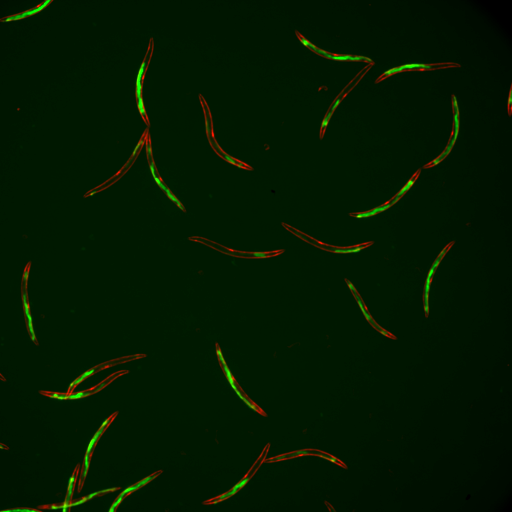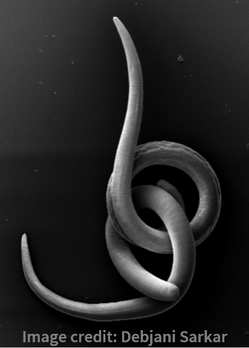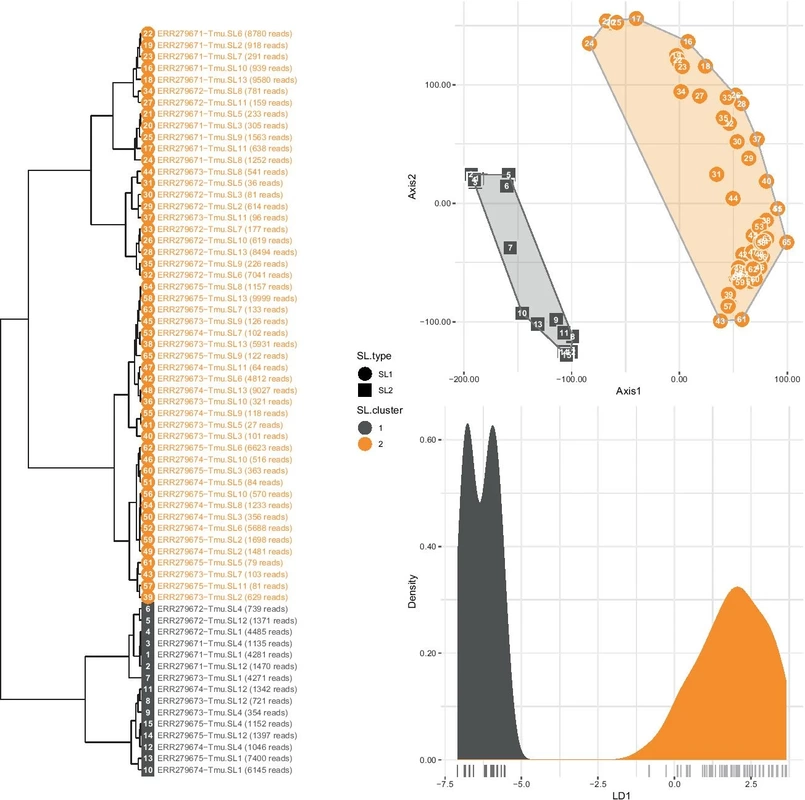|
C. elegans expressing GFP (green) in their intestinal cells in response to reduced spliced leader trans-splicing. This reporter system, which is described in Philippe et al. 2017, allows us to rapidly and robustly screen for molecules involved in trans-splicing.
|
Nematode Spliced Leader trans-Splicing
Spliced leader trans-splicing is an RNA splicing mechanism used by many eukaryotic groups (including many important human and animal parasites) to generate the 5’ ends of their mRNAs. The mechanistic details of this process are not well understood, and we are using the model animal C. elegans to gain insight into the key molecules involved. Better understanding of spliced leader trans-splicing has the potential to facilitate the development of new drugs to treat parasitic infections. Eijlers P, Al-khafaji M, Soto-Martin E, Fasimoye, R, Stead D, Wenzel, M, Müller, B and Pettitt J. (2024). A nematode-specific ribonucleoprotein complex mediates interactions between the major nematode spliced leader snRNP and its target pre-mRNAs. Nucleic Acids Res. https://doi.org/10.1093/nar/gkae321 Fasimoye RY, Spencer REB, Soto-Martin E, Eijlers P, Elmassoudi H, Brivio S, et al. (2022). A novel, essential trans-splicing protein connects the nematode SL1 snRNP to the CBC-ARS2 complex. Nucleic Acids Res. 50, 7591–7607. https://doi.org/10.1093/nar/gkac534 Pandarakalam GC, Speake M, McElroy S, Alturkistani A, Philippe L, Pettitt J, et al. A high-throughput screen for the identification of compounds that inhibit nematode gene expression by targeting spliced leader trans-splicing. Int J Parasitol Drugs Drug Resist. 2019;10: 28–37. Philippe L, Pandarakalam GC, Fasimoye R, Harrison N, Connolly B, Pettitt J, et al. An in vivo genetic screen for genes involved in spliced leader trans-splicing indicates a crucial role for continuous de novo spliced leader RNP assembly. Nucleic Acids Res. 2017;45: 8474–8483. |
|
Scanning electron micrograph of Trichinella spiralis new born larvae
|
SL2 and Polycistronic RNA Processing in Nematodes
The organisation of multiple genes into a single transcriptional control unit, termed an operon, is a common feature of prokaryote genomes. Although, less prevalent in eukaryotes, this gene expression strategy is found in a substantial number of unicellular and multicellular taxa. A common feature of all eukaryotic operons is the presence of spliced leader trans-splicing. This mechanism is an essential element in the generation of mRNAs derived from genes situated downstream of the first gene in an operon (downstream operonic genes); the spliced leader RNA carries a cap structure on its 5’-end, which allows the trans-spliced mRNAs to be recognised by the translation machinery. Addition of the spliced leader is also thought to prevent termination of transcription following polyadenylation of the upstream mRNA. Wenzel M, Johnston C, Müller B, Pettitt J, Connolly B. Resolution of polycistronic RNA by SL2 trans-splicing is a widely conserved nematode trait. RNA. 2020;26: 1891–1904. dx.doi.org/10.1261/rna.076414.120 Pettitt J, Philippe L, Sarkar D, Johnston C, Gothe HJ, Massie D, et al. Operons are a conserved feature of nematode genomes. Genetics. 2014;197: 1201–1211. academic.oup.com/genetics/article/197/4/1201/6074069 |
|
Typical output from SLOPPR showing the presence of SL2-type spliced leader trans-splicing (orange shading) in Trichuris muris. For more information, see Wenzel et al., 2021
|
Computational Analysis of Spliced Leader trans-splicing
In collaboration with Marius Wenzel, we have developed a suite of tools that allow us to interrogate transcriptome and genome data for the presence of spliced leader trans-splicing and eukaryotic operons. SLIDR (Spliced Leader IDentification from RNA-Seq data) detects the presence of spliced leaders at the beginning of mRNAs and, if given a genome assembly, can identify the genes encoding the spliced leader RNAs. SLOPPR (Spliced Leader-informed OPeron Prediction from RNA-Seq data) is a genome annotation tool that uses information from the presence of spliced leaders in a transcriptome to predict genes likely to be organised into operons. Wenzel M, Müller B, Pettitt J. SLIDR and SLOPPR: flexible identification of spliced leader trans-splicing and prediction of eukaryotic operons from RNA-Seq data. BMC Bioinformatics. 2021;22. doi:10.1186/s12859-021-04009-7 bmcbioinformatics.biomedcentral.com/articles/10.1186/s12859-021-04009-7 |
Proudly powered by Weebly



